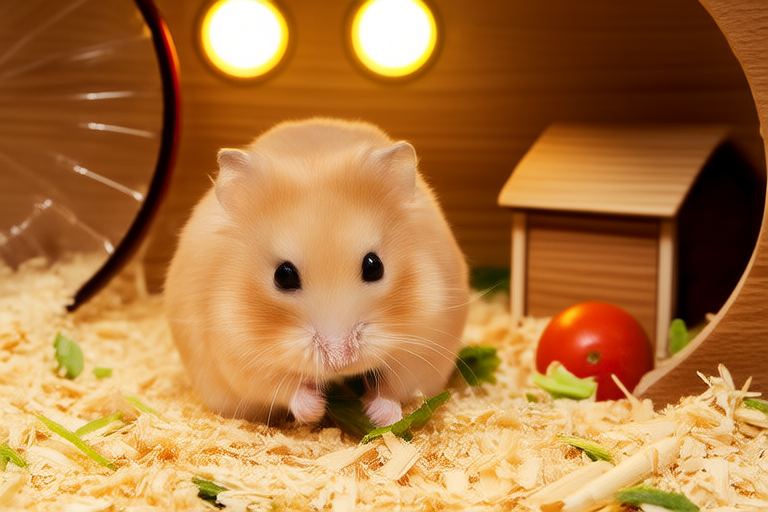How to Create the Perfect Habitat for Your Lovable Golden Hamster
Welcome to the wonderful world of golden hamsters! These cute little creatures are not only adorable but also quite easy to care for. However, creating the perfect habitat for your golden hamster requires attention to detail. In this guide, we’ll walk you through everything you need to know about setting up the ideal environment for your furry friend.
The Essential Components of Your Hamster’s Home
Size Matters: Choosing the Right Cage
The first step in creating a perfect habitat is choosing the right cage. The size of the cage is crucial as it will determine how much space your hamster has to move around and explore. For a single golden hamster, a cage that is at least 36 inches long, 18 inches wide, and 18 inches high is recommended. This provides ample room for your hamster to run, play, and sleep comfortably. Remember, larger is always better when it comes to cages!
Bedding: Soft, Comfortable, and Safe
Next, let’s talk about bedding. The bedding you choose for your hamster’s cage should be soft, comfortable, and safe. Avoid cedar and pine shavings as they can irritate your hamster’s respiratory system. Instead, opt for paper-based bedding or recycled paper products. These materials are not only safer but also more absorbent, helping to keep the cage clean and dry.
Hideouts: Providing a Cozy Retreat
Your hamster will need a cozy retreat where it can feel secure and safe. Provide a variety of hideouts such as tunnels, hammocks, and small boxes. These hideouts should be large enough for your hamster to fit inside comfortably but not so large that they become difficult to navigate. Make sure to rotate the hideouts regularly to keep things interesting for your pet.
Dietary Needs: What to Feed Your Golden Hamster
Golden hamsters are omnivores, which means they eat both plants and animals. Their diet should consist of a balanced mix of seeds, fruits, vegetables, and protein. A good quality commercial hamster food mix is a great starting point. You can supplement this with fresh fruits and vegetables like carrots, apples, and leafy greens. Always make sure to introduce new foods gradually to avoid digestive upset.
Exercise Opportunities: Keeping Your Hamster Active
Just like humans, hamsters need regular exercise to stay healthy and happy. Provide your hamster with a running wheel or a hamster ball for exercise. Make sure the wheel is the appropriate size for your hamster, with a solid surface to prevent injuries. Additionally, consider adding toys and obstacles to the cage to encourage exploration and mental stimulation.
Temperature and Lighting Requirements
Golden hamsters are native to Syria, so they prefer moderate temperatures between 65°F and 75°F. Avoid placing the cage near drafts, direct sunlight, or heat sources. As for lighting, hamsters are nocturnal creatures, meaning they are most active during the night. They don’t require specific lighting conditions, but it’s important to maintain a consistent day-night cycle to help regulate their circadian rhythms.
Cleaning Schedules: Maintaining a Clean Habitat
A clean habitat is essential for your hamster’s health and well-being. Plan to clean the cage once a week, removing all bedding and thoroughly scrubbing the cage with a mild soap solution. Replace the bedding with fresh, clean material after each cleaning. Spot clean the cage daily to remove any waste and food debris.
Safety Precautions: Ensuring Your Hamster’s Well-being
When setting up your hamster’s habitat, there are several safety precautions to keep in mind. First, ensure that all cage accessories have smooth edges to prevent injuries. Second, avoid using any materials that could be toxic to your hamster, such as plastic toys that may contain harmful chemicals. Finally, provide a water bottle with a sipper tube instead of an open water dish to prevent spillage and contamination.
Tips for Enrichment and Bonding
Enrichment Activities
To keep your hamster mentally stimulated, try introducing new toys and activities into its environment. Rotate these items regularly to keep things interesting. Consider adding tunnels, bridges, and other structures to encourage exploration. You can also offer treats in small quantities as a reward for positive behaviors.
Bonding Tips
Bonding with your hamster takes time and patience. Start by spending time near the cage, talking softly to your pet. Gradually introduce your hand into the cage, allowing your hamster to sniff and get used to your scent. Once your hamster feels comfortable, you can begin handling it gently. Always support your hamster’s body when holding it to prevent injury.
Conclusion
Creating the perfect habitat for your golden hamster involves careful consideration of various factors, from the size of the cage to the type of bedding and toys provided. By following these guidelines, you can ensure that your hamster has a safe, comfortable, and stimulating living environment. Remember, a happy hamster is a healthy hamster, and with proper care, your furry friend will thrive in its new home.
